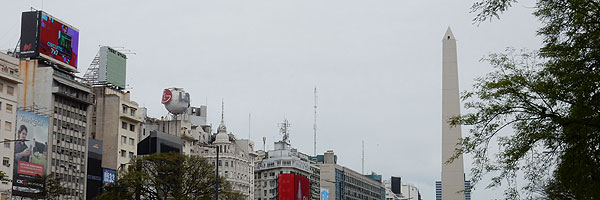City of the Dead
Today is November 2, Día de los Muertos (Day of the Dead). This holiday is celebrated with a lively intensity in Mexico and Central America, with a powerfully spiritual emphasis on honoring ancestors and loved ones who have passed away. One of the most important aspects of Día de los Muertos is a trip to the cemetery, where families have picnics on the graves of their ancestors. The holiday is not really celebrated in Argentina, but I thought it would nevertheless be a good day to go to the cemetery in a symbolic gesture. And not just any cemetery—Recoleta is a veritable city of the dead.
I took the Subte to Retiro Station, and then took a taxi the short distance to Recoleta. As soon as I entered the cemetery, I could tell that it was more than an ordinary cemetery. Three-story mausoleums crowned with statues lined streets and boulevards that gave the place the air of a sprawling city. It has 4,800 mausoleums crammed together in an area of 14 acres. It was the first public cemetery in Buenos Aires, first developed in 1822.
Recoleta Cemetery is hallowed ground for Argentine history, culture, and literature. It is the final resting place for many of the country's former presidents, politicians, military heroes, writers, and poets. As I walked through the grand boulevards and narrow alleyways that linked the vast cemetery, I saw many names that I recognized from readying the history of Argentina. Hipólito Irigoyen, Carlos Pellegrini, and Bartolomé Mitre were all former presidents of Argentina. Victoria Ocampo was one of the greatest Argentine writers of the 20th century.
The most popular destination for visitors to Recoleta, however, is the mausoleum for the Duarte family. This is where María Eva Duarte de Perón, known more popularly as "Evita," is sepulchered. The mausoleum is on one of the smaller streets in the cemetery, but easy to find by following the crowds. Adorned with flowers and small offerings, the mausoleum usually has a group of people in front of it, sometimes an entire tour group, taking photos, leaving flowers, or paying their respects.
When I left Recoleta, I took a break on the spacious lawn in front of the cemetery. Then I took a taxi back to Retiro and continued my exploration of Buenos Aires. My next destination was a unique place indeed, a building inspired by Dante's Divine Comedy.
| Next up: The Palacio Barolo |


© 2016 Michael Hanrahan